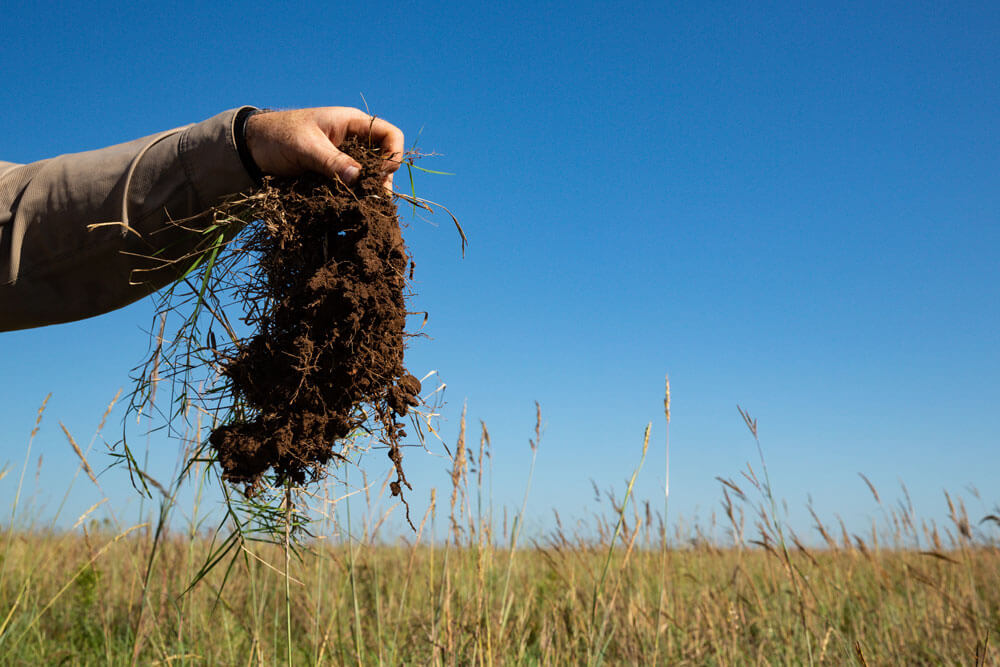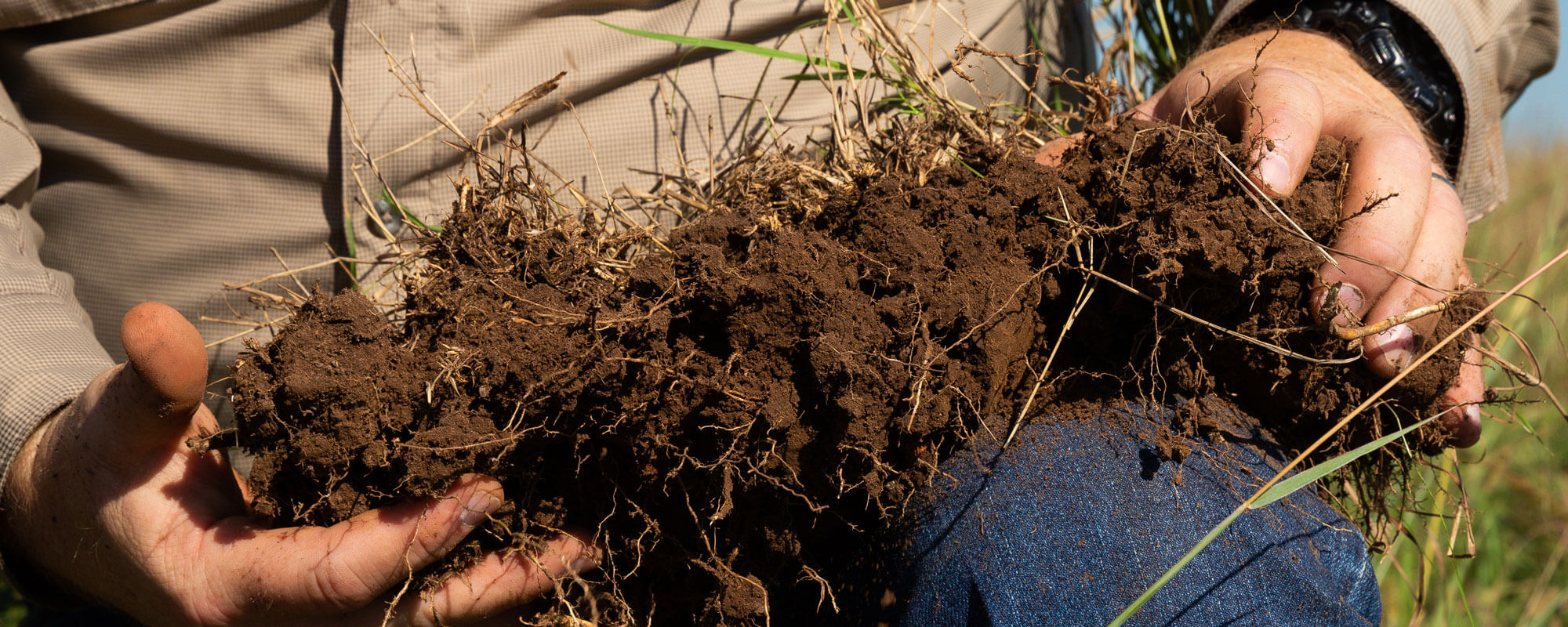Soil health has become an important rallying point for many people involved with regenerative agriculture, including researchers, food companies and producers.
Noble defines regenerative agriculture as the process of restoring degraded soils using practices based on ecological principles. In general, that means focusing on the capacity of the soil to sustain fundamental processes essential for microbes, plants, animals and people to thrive.
Soil carbon is widely regarded as one of the most important metrics of soil health and refers to the amount of carbon (primarily in organic matter) found in the soil. We can recognize soils high in soil carbon by their darker color and rich, earthy smells.
Regenerative agriculture is the process of restoring degraded soils using practices based on ecological principles.
Increasing soil carbon is linked to greater water infiltration and holding capacity of the soil, which can help grazing lands withstand droughts. At the same time, drawing soil carbon from the atmosphere could help decrease atmospheric CO2 levels.
So, if soil carbon is so good, what can we do to build soil carbon? The answer is complex and requires a little deeper understanding of the carbon cycle.
Carbon Cycle Basics
Plants pull carbon from the atmosphere during the process of photosynthesis to build sugars that they use for growth and energy. Investment of this sugar to build and maintain healthy root systems is a major component of the plant’s carbon budget.
Roots take up water and nutrients, and they release many different compounds known as root exudates that range from mucilage to small molecules like sugars. These exudates are commonly thought to feed the soil’s complex microbial community, in effect transferring carbon from the plant to microbial cells.
When either roots or microbes die, they decay through chemical and biological decomposition, which frees more carbon to enter soil fractions. The two major soil fractions are believed to be particulate organic matter made of larger fragments and mineral-associated organic matter made of smaller molecules that are bound to soil mineral particles. Particulate organic matter is thought to be shorter lived than mineral-associated organic matter.
How Can We Build Soil Carbon?
Applying the six soil health principles serves as a great foundation because each principle can influence the processes involved with building soil carbon.
A precursor to building healthy soils is keeping them protected and covered. Keeping plant litter and living shoots on top of the soil acts to conserve soil moisture and regulate temperature, which will promote plant growth, including the root system to feed soil microbes. Together, these will act to increase carbon inputs and, ultimately, ensure that the soil is protected from disturbances that disrupt natural soil activities.
Tillage exposes fresh soil, along with its carbon and microbes, to oxygen. This leads to a widely documented “burning off” of soil carbon. Soil carbon burn-off is caused by a microbial population explosion that consumes all the carbon as energy and is released as CO2, just like when a person breathes out.
Soil disturbances also disrupt soil structure, which is important for exposing mineral surfaces that act as binding sites for soil carbon. Luckily, activities of roots, microbes and soil biology all lead to greater porosity with regenerative capacity.
Increasing Biodiversity
Increasing plant diversity is another way to aid in building soil health. Plant diversity has been seen to promote overall plant community growth, which drives greater root growth and carbon inputs. At the same time, the rich underground environment made through diverse roots and exudates leads to greater microbial diversity and functioning.
A focus on plant diversity provides a pathway to promote plants that keep living roots in the ground all year. This principle has two effects, one by increasing the total input of dead roots, and the other by increasing the input of exudates (microbe chow.)
Dead roots may lead to greater particulate organic matter, while exudation may lead to greater microbial activity and eventually greater mineral-associated organic matter.
Importantly, keeping these processes sustained over time leads to a more stable soil community that is more resilient. Ultimately, the management of these plants with a focus on ecological processes should be facilitated by properly integrating livestock.
Livestock promote other principles directly by promoting plant growth, including the roots when plants aren’t overgrazed and increasing plant diversity. Livestock manure also serves as a rich source of soil carbon.

Root Functions
Although plant leaves produce more than 95% of the food for the plant on a dry weight basis, the roots, provide the framework for plants to function while providing direct benefits to multiple organisms.
Plant roots provide multiple functions but core to those are:
- Plant anchorage
- Nutrient and water uptake
- Nutrient transfer
- Energy storage
Types of Roots
Some plants have strong, thick tap roots, more consistently found in broadleaved herbaceous plants, which can aid in breaking up soil compaction.
Root systems with many fine roots that are densely packed, most commonly found in grasses, can grow quite deep and provide considerable soil stabilization to stream banks, riparian areas, or other areas prone to wind or water erosion. So, one way to manage soil carbon is using roots as scaffolding that prevents erosion and keeps hard-earned soil carbon in place.
Plants and Microbes
Plants need specific nutrients and water to survive, and most of those are facilitated through the plant’s roots. While plants can uptake water and nutrients themselves, they do not have the luxury of any method of travel when limitations occur. However, they do have the ability to develop symbiotic relationships with organisms that help extend their reach.
Many plants develop associations with mycorrhizal fungi. Mycorrhizal fungi attach themselves to the plant roots, and in return, for energy from the plant, it provides a mechanism for water uptake and is even known to aid in solubilizing phosphorus.
Ultimately, plants provide an energy source for a multitude of biological soil organisms. Plants produce and exude compounds that feed soil microbes, providing nutrients like nitrogen in plant available forms.
Roots and Carbon
Roots and crowns are important for energy storage in perennial plants. When perennial plants come out of dormancy, they need the carbohydrates stored in the crown and roots to use as reserved energy until the plant has the ability to form enough leaves early in the spring to start charging its batteries, so to speak.
In the end, roots help plants transfer carbon in all three states of matter: liquid (plant exudates in solution), solid (plant root material) and gas (such as CO2 or CH4). All three states have an impact on the ability for us to sequester carbon in our soils by targeting the various soil carbon fractions.
Building Soil Carbon
Typical soils range from 1-5% percent soil carbon by weight.
Because of carbon cycling by microbes, building soil carbon is complex and does not simply equal the carbon inputs from roots and plant litter.
Typically, we expect more degraded soils with lower carbon levels to have the capacity to build soil carbon faster, as long as the soils can sustain plant communities. Recent evidence suggests that soil mineral surfaces can become full, or saturated, which may limit mineral-associated fraction that acts as a long term storage. Still, high levels of particulate organic matter can be sustained and have been shown to continue building even after the minerals are saturated.
Test Your Soil Carbon
We recommend having your soil carbon tested today and challenging yourself to build this carbon. In doing so, you will become a more intentional producer and have a realistic, objective metric for the regeneration of your operation.



Comments